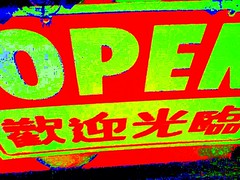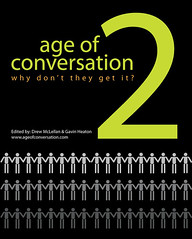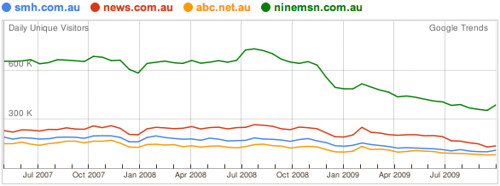 Back in 2007 it was a struggle to explain to people what “blogging” was all about. At dinner parties, people would grill me about blogging, about its relevance to business and about the weirdness of writing for a handful of readers. So when Drew McLellan and I decided to try and pull together 100 of the world’s most thoughtful and articulate marketers to share their experiences (both professional and individual) about blogging, we didn’t know what to expect. Could we REALLY turn it into a book?What would the content be like? How many people would actually DELIVER their chapters? How would the book be received?
Back in 2007 it was a struggle to explain to people what “blogging” was all about. At dinner parties, people would grill me about blogging, about its relevance to business and about the weirdness of writing for a handful of readers. So when Drew McLellan and I decided to try and pull together 100 of the world’s most thoughtful and articulate marketers to share their experiences (both professional and individual) about blogging, we didn’t know what to expect. Could we REALLY turn it into a book?What would the content be like? How many people would actually DELIVER their chapters? How would the book be received?
Well, it’s over two years later. The book that we published, The Age of Conversation, spurned a follow-up edition, The Age of Conversation 2: Why Don’t They Get It. We grew the author base from 100 to 237. We were mentioned in the press and on blogs around the world, and even made the reading list for undergraduate marketing courses across the US. In the process, we raised well over $20,000 for charity (all proceeds from the first two books were donated to Variety the Children’s Charity).
 Much has changed in the last two years. New platforms, tools and approaches have been tried. Some remain, many have fallen by the wayside. Businesses, public and private organisations and Not For Profits of all shapes and sizes are dipping their toes into the conversational water; agencies and independent consultants are wading in (some taking the full body immersion option); and together – often in spite of our best practices and efforts – we are ALL learning that there is much more to “social media” and its impacts than we could have first imagined.
Much has changed in the last two years. New platforms, tools and approaches have been tried. Some remain, many have fallen by the wayside. Businesses, public and private organisations and Not For Profits of all shapes and sizes are dipping their toes into the conversational water; agencies and independent consultants are wading in (some taking the full body immersion option); and together – often in spite of our best practices and efforts – we are ALL learning that there is much more to “social media” and its impacts than we could have first imagined.
Sure there are some success stories, but we are a long way from consensus.
It is in this landscape that we are launching a call for authors for a NEW collaborative book – The Age of Conversation 3. The approach remains the same as the previous editions.  Each author will be able to submit one 400 word article. To make sure the content is varied and to avoid repetition, we've created 10 section topics. Each author will select one topic and then direct the content of their submission accordingly. There will be a maximum of 30 authors per section.
Each author will be able to submit one 400 word article. To make sure the content is varied and to avoid repetition, we've created 10 section topics. Each author will select one topic and then direct the content of their submission accordingly. There will be a maximum of 30 authors per section.
The sections you can write for are:
- Conversational Branding
 Influence
Influence  Getting to Work
Getting to Work  Corporate Conversations
Corporate Conversations  Measurement
Measurement  In the Boardroom
In the Boardroom  Pitching Social Media
Pitching Social Media  Innovation and Execution
Innovation and Execution  Identities, Friends and Trusted Strangers
Identities, Friends and Trusted Strangers  Conversation at the Coalface (If you work at the coalface, you deal with the real problems and issues, rather than sitting in a office discussing things in a detached way.)
Conversation at the Coalface (If you work at the coalface, you deal with the real problems and issues, rather than sitting in a office discussing things in a detached way.)
As you have probably figured out, we are capping participation at a maximum of 300 authors. So if you want to join what has become a global publishing event, you will need to MOVE FAST. You can sign up HERE.
What’s in it for you?
Your contribution to The Age of Conversation places you in esteemed company. Many of our past collaborators are well known authors in their own right, are respected thought leaders in a range of fields (from marketing through NFP, within the enterprise, in education and as business leaders) or distinguish themselves as community leaders in other ways.
Your article will appear in what we think will be one of the must-read books of 2010. If you have not been published before, this is your chance to collaborate on a business book with a global audience. There will be link love (to your blog or website), there will be opportunities to raise your profile via podcast, interviews and even book readings – and you will be raising money for a worthwhile charity.
In return, you will be asked to sign an author release:
- The author release will bind you to promoting the book on your blog, Twitter and other social tools. If you cannot commit to helping us promote the book, please don’t ask to participate.
- You handover your rights to your article and in return we will donate all proceeds to charity.
- This time, we are going to let the authors vote on the charity that will receive the proceeds (with some help from Beth Kanter)
- You commit to submitting your entry by November 1, 2009.
Wait! Hasn’t it all been said already?
At the time of the first Age of Conversation, Todd Andrlik’s Power 150 list of social media and marketing blogs really only had 150 entries. These days, now under the auspices of Charlie Moran at Ad Age, the Power 150 boasts over 1000 entries. Not only are MORE blogs being created, more writers are emerging with unique perspectives and new insights. There has never been a better time to be part of this global conversation. What are you waiting for? SIGN UP HERE.
 I like the concept of awesomeness – at least in the context of the Awesomeness Manifesto. Having worked in the fields of business innovation, process improvement, creativity and advertising for well over a decade now, it certainly feels that the term “innovation” suffers from its industrial age underpinnings. It is not JUST that innovation relies on obsolescence – but more that innovation can occur almost without human agency. This is especially true in business where workflows are automated, connections are streamlined and processes optimised.
I like the concept of awesomeness – at least in the context of the Awesomeness Manifesto. Having worked in the fields of business innovation, process improvement, creativity and advertising for well over a decade now, it certainly feels that the term “innovation” suffers from its industrial age underpinnings. It is not JUST that innovation relies on obsolescence – but more that innovation can occur almost without human agency. This is especially true in business where workflows are automated, connections are streamlined and processes optimised.





 Each author will be able to submit one 400 word article. To make sure the content is varied and to avoid repetition, we've created 10 section topics. Each author will select one topic and then direct the content of their submission accordingly. There will be a maximum of 30 authors per section.
Each author will be able to submit one 400 word article. To make sure the content is varied and to avoid repetition, we've created 10 section topics. Each author will select one topic and then direct the content of their submission accordingly. There will be a maximum of 30 authors per section.